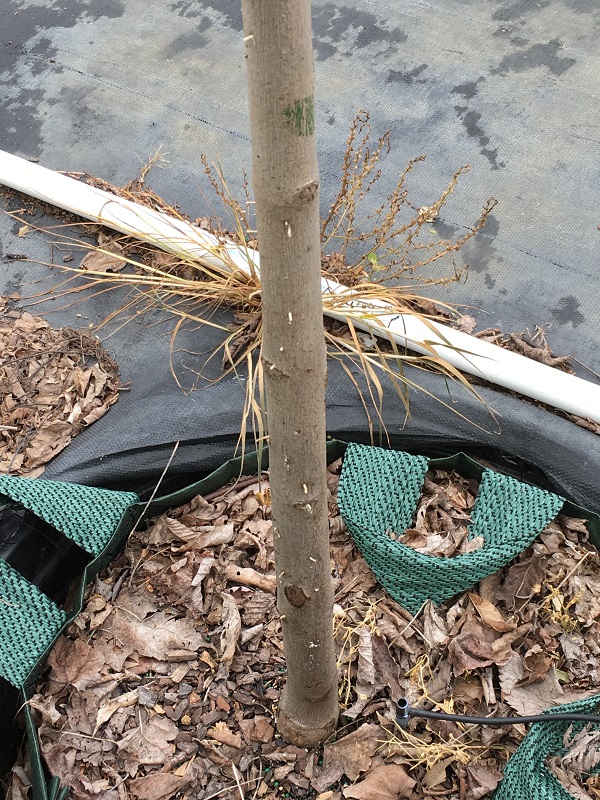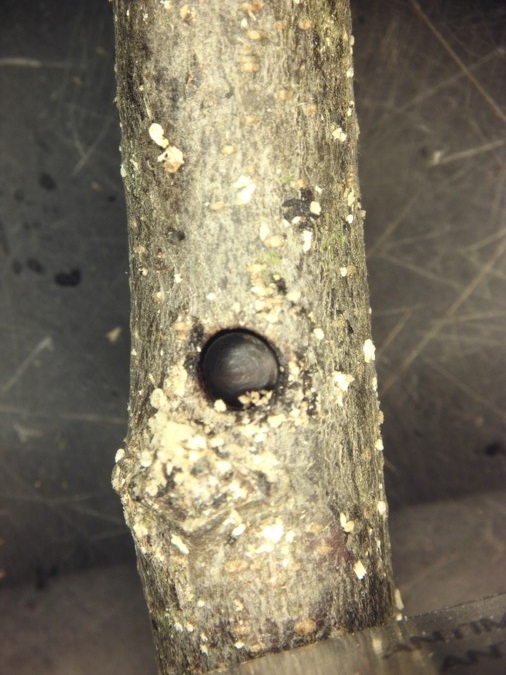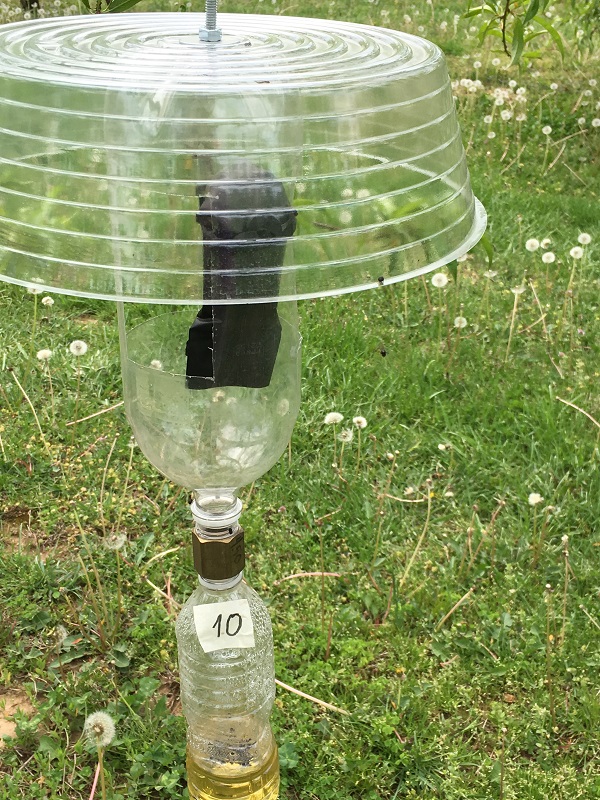Non-Native Ambrosia Beetles: Damage and Management
ENTFACT-468: Non-Native Ambrosia Beetles: Damage and Management | Download PDF
by Zenaida Viloria (Entomology Extension Staff), Raul T. Villanueva (Entomology Extension Specialist), Win Dunwell Horticulture Extension Specialist), and Ric Bessin (Entomology Extension Specialist)
University of Kentucky College of Agriculture
Ambrosia beetles are small insects (1.6-4.0 mm long), whose preferred habitats are weakened and dying woody plants. Ambrosia beetles build galleries in the sapwood where they breed and farm fungi as their only food source. These fungi, collectively called ambrosia, break down the wood and produce nutrients for the developing brood and adults. Ambrosia beetles overwinter in the galleries as adults and begin to emerge in the spring, when trees start to leaf out, which coincides with a temperature increase to at least 68o F for 2-3 days. Female beetles mate prior to leaving their galleries in search of new hosts to colonize. Non-native ambrosia beetles are more aggressive and damaging than native species. Non-native species attack living and apparently healthy plants resulting in their death. Thus far, 45 exotic ambrosia beetle species have established in the USA. Five of them are considered serious pests. Granulate ambrosia beetle (Xylosandrus crassiusculus), camphor shot borer (Cnestus mutilatus) and black stem borer (Xylosandrus germanus) (Figure 1) are non-native species commonly found attacking nursery crops, apple orchards and landscape plants in Kentucky.

Figure 1. A) Camphor shot borer B) Granulate ambrosia beetle) and C) Black stem borer, D) Size comparison in millimeters. (Photos by Zenaida Viloria)
Damage
Ambrosia beetles drill the cortex to reach wood where they make tunnels and inoculate the wood with fungi, which they carry in specialized structures in their body. Sawdust, produced as a result of their drilling, is pushed out forming strands or sticks of frass (called toothpicks) that protrude from the stem or branch (Figure 2). These strands are a typical symptom of ambrosia beetle attack, since ambrosia beetle holes and the beetles themselves are often difficult to see. However, the frass toothpicks cannot be detected after windy days or a rainfall because they are easily blown or washed away. A short time after the attack, plants might show symptoms of wilting or dieback until they finally die. It is unknown what causes plant death; plant death may be caused by beetles girdling of the vascular tissue and/or by the action of pathogenic fungi introduced into the plant by the beetles. Ambrosia beetles breed in a wide range of hosts, mainly broadleaf woody plants, where they farm their symbiont fungi. More than 200 plant species have been reported as hosts, among them: aspen, beech, cherry, Chinese elm, crape myrtle, dogwood, golden rain tree, hickory, magnolia, maple, mimosa, oak, peach, persimmon, Prunus, redbud, sweetgum, tulip, poplar, Styrax, and walnut are listed as species susceptible to ambrosia beetle attack. These plant species may be more prone to biotic and abiotic stresses and therefore more likely to attract ambrosia beetles. Plant stress caused by flooding, drought, freeze damage and poor management practices make plants release ethanol, the major ambrosia beetle attractant. Climate change might influence ambrosia beetle damage by predisposing plants to attack due to more frequent flooding, drought, or freeze damage in regions where these events were previously rare. Ambrosia beetles attack a broad range of tree sizes. Eastern redbud branches thinner than a pencil (Figure 3) and 30-cm diameter trees have been attacked, however, higher attack frequencies have been reported for 3-3.9-inch diameter trees. In recent years, attacks have been seen in maple, tulip poplar, willow oak, cherry trees grown in containers and landscape redbuds.

Figure 2. Maple tree recently attacked by granulate ambrosia beetle. Frass toothpicks can be noticed from close to the ground to more than 3 feet height. (Photo: Ginny Travis)

Figure 3. Camphor shot borer drills an Eastern redbud twig (~6mm). (Photo: Brenda Kennedy)
Management
Monitoring and scouting are the best approaches to detect ambrosia beetle activity and check population trends. Traps baited with ethanol (Figure 4) are effective for attracting overwintering adults in early spring as they begin to search for new trees to colonize. In western Kentucky, ambrosia beetle population peaks for granulate ambrosia beetle, camphor shot borer and black stem borer were recorded in April in 2016 and 2017. Black stem borer is found in low numbers (Figure 5). In 2018, the unusual cold spring moved the population peaks to early May and reduced the overall population level. Trapping must be complemented with tree inspection to spot the typical frass toothpicks (Figure 2). Infested trees must be removed from the nursery and burned. Keeping plants healthy through proper nutrient and water management practices is the primary strategy to avoid ambrosia beetle attacks. For container plant production, it is recommended to maintain 50% substrate moisture. If this is not possible due to spring rain, pyrethroid application every two weeks may be needed during periods of adult flight activity. Systemic insecticides are not effective because these insects do not feed on the plants, only the fungi. For more information, consult your county extension office.

Figure 4. Modified Baker trap baited with ultra-high release ethanol. Camphor shot bores can be noticed hovering around and some more in the caching bottle. (Photo: Zenaida Viloria)

Figure 5. Seasonal flight pattern of granulate ambrosia beetle, camphor shot borer and black stem borer in western Kentucky.
Acknowledge: We thank to the Specialty Crop Block Grants of the Kentucky Department of Agriculture for providing funds for this study, and to the Nursery farmers and apple growers of Kentucky for allowing us to monitor ambrosia beetles in their properties. We are thankful to Dr. Karla M. Addesso (Tennessee State University) for providing valuable comments to a previous version of this publication.
